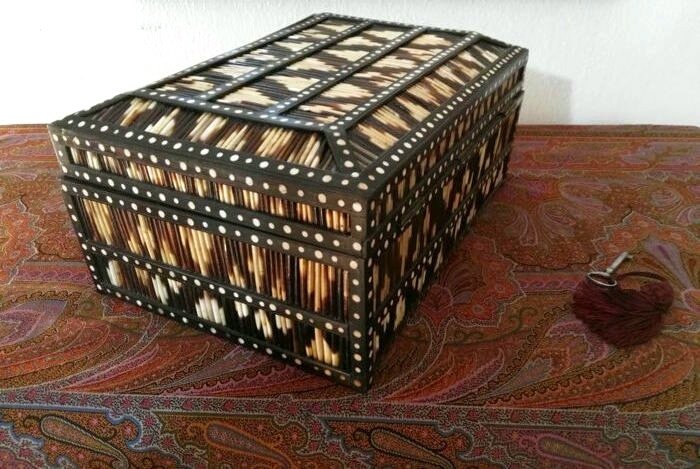
馬桶套裝 (3) - J & R Griffin -
編號 22777951

編號 22777951

There are numerous variations of porcupine quill boxes on the market, and they vary enormously in quality. As a general rule, the more inlay and marquetry work that has gone into the box likewise quantity and quality of the porcupine quills used, the finer and rarer it is.
The existence of an inner compartmented tray and bigger size are good indication of a valuable box, vaulted top lid and interior with scenery is also a detail which signposts the highest grade. Conversely, those with finer (higher fringe number) quills are much more desirable and thus valuable.
The most common Ceylonese ebony & porcupine quill store-box type are 8-9 up to 10 inches in width, typically among those boxes is a plain lid and no inner scenery, as well as poor/ or absent inner inlaid and/ or absent inner tray - is the most spread version.
However, there is a small group of porcupine quill boxes that tend to be exquisite in the use of quills, ivory, and bone inlay and inner adornment. In general, boxes larger than 12 inches wide tend to be superior; they were intended for the more distinguished client who could afford the extra size and detail as well as the quantity and quality processing deployment.
That model represents this kind (rarely exceed the 11-22 inches) of an example of Anglo - Sinhalese porcupine quill box type associated with the southern Sri Lankan port town of Galle.
It shows one of the biggest sizes in its kind and a distinctive bone disc inlaid surface maximum, vaulted covering lid with inner scenery -and further inlaid- embellishment, its inner removable 9 covered compartment tray has massive ebony and coromandel planks, profusely ornated with dot overlay, geometrical indelible shellac patterns and brass pull-hoops embellished with pewter rosettes.
The vaulted box is made of solid black and coromandel ebony splints, strips and planks on a sandalwood skeleton. It is extravagantly allover ornated with porcupine quill panels bounded by inlaid ebony strips; the ebony strips are lengthwise on all sides and on the hinged ivory bone dot-inlaid lid. Likewise the upright-zigzagging motif quill panels. Its interior is fitted with a nine compartment tray. The vault´s roof displays a likewise inlaid ebony panel edged surrounded by a border of deep blue flannel-like fabric, the panel displays an opposing elephants scenery below southern Sri Lankan port town name 'GALLE'.
Together with the use of the quills finest sections and qualities used to make chevron patterns (fringed quill instead of plain quill parts and cream to brownish instead of lower quality yellowish ones) is associated only with the best quality victorian Anglo-Sinhalese craftmanship, created for export and sale to British and European aristocracy, diplomats and colonial army officers. Boxes such as this example were used by ladies to store jewelry, sewing utensils, and hair ornaments. Ceylon was part of the British Indian Colony and was not a separate country at that time, hence, the boxes that were made in Ceylon were (and are still) categorized as Anglo-Indian, despite being Anglo-Ceylonese. Those pieces were highly priced already to its time.
Fine condition. The hinged lid fits some unevenly (mm), seemingly due to some humidity fluctuation (considering its tropical Indo-Malayan origins and it's over 150 years of age, quite reasonable). Not a single inlay dot missing. There are neither further losses nor damages. Original inner tray. It retains the original functional lock and keyhole scutcheon as well as -less usual- its key. Seldom in this size and finishing standard. Black ebony (Diospyros celebica) wood, Coromandel ebony (Diospyros melanoxylon) wood, crested porcupine (Hystrix indica) quills, native elephant ivory (Elephas maximus maximus), bovine bone, sandalwood (Santalum album), vegetal fabric, natural (Laccifer lacca) beetle shellack ink, pewter, brass, iron. British Raj (colonial India), circa 1850 to 1870.
Provenance: Old Sevillian collection. Northern Castilian collection. Most probably in Spain already during the XIXth century. Dimensions: 31'6 cm Long x 22'4 cm Deep x 15cm High. Weight: 3,15 kilogram. Age & Authenticity expert certified stating its exact age (1850–1870) included.
References:
Coomaraswamy, A.K., Mediaeval Sinhalese Art, Pantheon Books, 1956. Jaffer, A., Furniture from British India and Ceylon: A Catalogue of the Collections in the Victoria and Albert Museum and the Peabody Essex Museum, Timeless Books, 2001. Tchakaloff, T.N. et al, La Route des Indes - Les Indes et L'Europe: Echanges Artistiques et Heritage Commun 1650-1850, Somagy Editions d'Art, 1998. Veenendaal, J., Furniture from Indonesia, Sri Lanka and India During the Dutch Period, Foundation Volkenkundig Museum Nusantara, 1985.